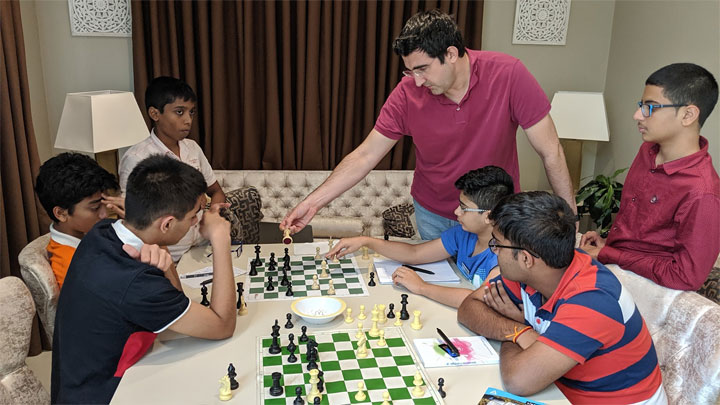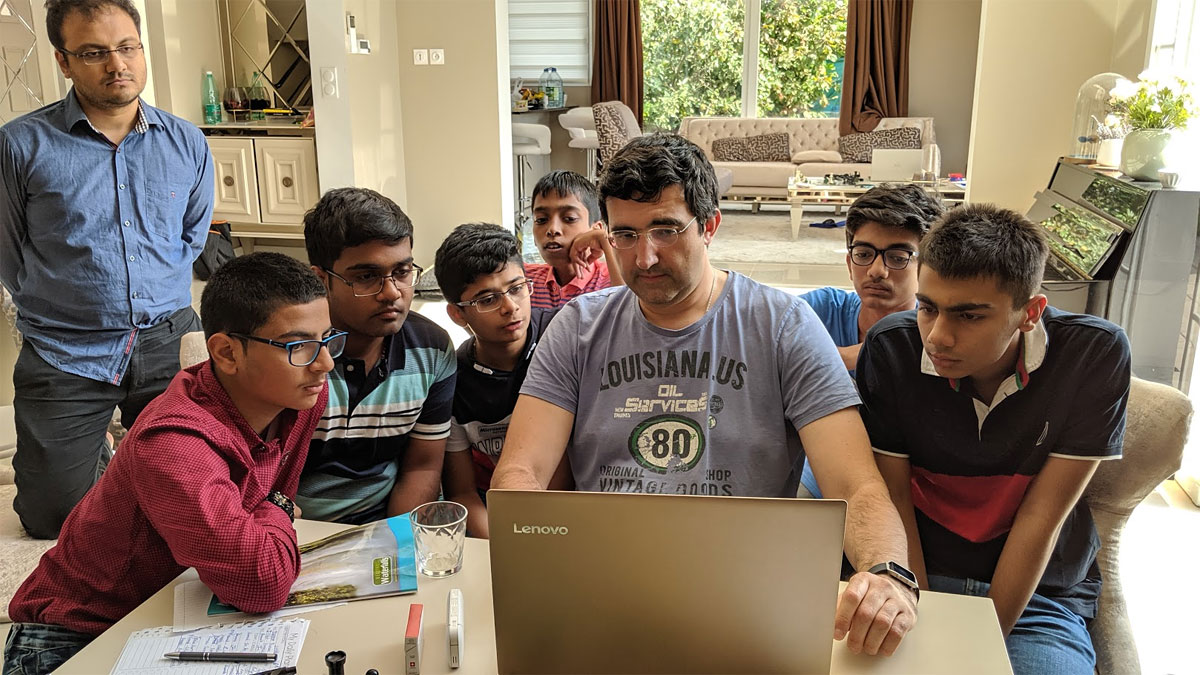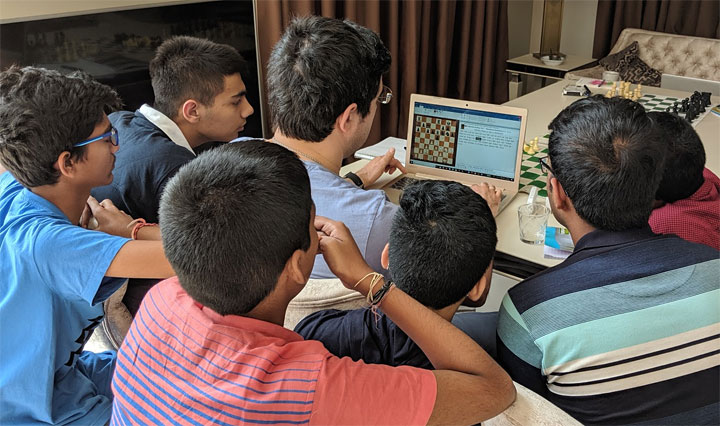.jpeg)

.jpeg)
ChessBase 17 - Mega package - Edition 2024
It is the program of choice for anyone who loves the game and wants to know more about it. Start your personal success story with ChessBase and enjoy the game even more.
I have known Vladimir Kramnik for 27 years now — he was first pointed out to me in Dortmund in 1992. He remains one of my best friends in chess. I enjoy his company, the debates we have on a variety of subjects, his unique sense of humour. And I know that he is one of the deepest chess players who has ever lived.
 So it was great that he agreed, after his retirement, to conduct training camps for six Indian super-talents — kids between the ages of 13 and 16, four with full GM titles. The training was financed by the Indian Internet service provider Microsense, and organised by Sagar Shah and Amruta Mokal of ChessBase India.
So it was great that he agreed, after his retirement, to conduct training camps for six Indian super-talents — kids between the ages of 13 and 16, four with full GM titles. The training was financed by the Indian Internet service provider Microsense, and organised by Sagar Shah and Amruta Mokal of ChessBase India.
I could not resist, and flew down to Geneva last Monday, to witness for myself how things were going. I knew just one of the kids personally: Gukesh Dommaraju, who in January, at the age of twelve, became the second-youngest grandmaster in history. I had, at the time, met him in Mumbai and then again in Chennai at his home. After that he came with his father to Hamburg, and the two stayed in my home. It was great fun.
The others in the Chens-Sur-Leman training camp I had not yet met, so it took many minutes to befriend them. Over three days I got on with all five extremely well, convincing them to abandon the "Frederic-sir" form of address, and joking and jesting like one big family. We spent a lot of time solving logical puzzles, something I will describe at some state in a separate article. Interestingly Vladimir joined in this non-chess activity with some puzzles of his own.

Click or tap to enlarge
Let me charaterise the camp participants briefly: Amruta and Sagar, on the left, are the organisers. Amruta had the daunting task of looking after everyone, and cooking, three meals a day for eight people — ten when Vlad and I were included. Sagar listened in on every session, entering games, positions and moves that were discussed into his computer, and including notes on what was said. That is a treasure trove for the players, who can revisit the indivual session in the coming months.
Standing next to Kramnik is GM Prithu Gupta from New Delhi, who last month became India's 64th grandmaster. He is fifteen and interested in practically everything. On a number of occasions he would approach me and ask questions about physics, our solar system, our galaxy and even the universe ("Do you believe there is life on other planets"). At one stage I gave him a 20-minute talk on why, if we discover life on Mars, humanity might be doomed. He listened intensely, never took his eyes off me, understood every twist of the though experiment.
On the other side of Kramnik is GM Iniyan Panneerselvam, at sixteen the oldest of the group. Iniyan is from Tamil Nadu and became India's 61st grandmaster in March this year. He was easily the best in the group at solving the logical puzzles I was giving them — and he kept coming for more.
On the right, with the oversized watch, is IM Raunak Sadhwani, who is thirteen and finished his IM title last year. He clearly loves the game — should I say he is addicted? He's play blitz in every free moment, usually with his bluetooth headphones on, listening to music. Here's a video of him playing an Armageddon against Prithu — in this case without the headphones.
Directly in front of Kramnik is GM Gukesh Dommaraju, son of Rajnikanth, an ENT surgeon, and Padma, a microbiologist. Since he visited us in Hamburg, together with his father, and they stayed in my house, he was not able to participate in the logical puzzles and tricks I wrought on the others. Guki had already seen them all.
In front of Gukesh, in the middle, is GM Praggnanandhaa Rameshbabu, who had turned fourteen just before the camp started. I told him he was a great problem for contemporary chess. Why? "Your name completely ruins any cross table." We agreed to use just Pragg R — "short enough?" Pragg and Guki are the super-talents you must watch carefully.
Between Sagar and Pragg is IM Leon Mendonca, who earlier this year caused a sensation by scoring three IM norms in 2½ weeks, gaining his title at the age of 12 years, 11 months and 3 days! He is now thirteen and lots of fun. Leon is a violin player — he actually brought the instrument along with him and played it for us in Chens-sur-Léman. It was a joy to listen to him practice.
Note that the appropriate form of address for these kids is Prithu, Iniyan, Raunak, Gukesh, Pragg and Leon. When they are older, people will formally call them Mr Iniyan, Mr Raunak, Mr Gukesh, etc. Only Prithu and Leon have Western-style surnames, the others mostly have their fathers' names tagged on. I explained this in detail fifteen years ago, when people were struggling with Anand.
Oh, yes, and the tall one in the background is Vladimir Kramnik. He is standing on a step (as is Prithu), so he is not as giant as would seem. Except of course in chess understanding and skill, which is what the others were in Chens-Sur-Leman for. It is explained in the article Vladimir Kramnik training six Indian super-talents and Fun and games with Kramnik and kids.

The visit was much more intense than I had anticipated. I watched them analysing and discussing with Vlad, usually seven hours a day, never being distracted or losing interest.

Look at the intensity of the six lads (click to enlarge) when working with Vladimir
In the last picture we see a very special session in progress. In it Vladimir showed them how to prepare for a specific opponent. He asked the youngsters to choose a player they might encounter in a future event, one he did not know. Once the player was chosen he said, "I am now going to prepare against him as if I am playing a game tomorrow, and assuming I have just a couple of hours in hand to figure him out."
It was simply amazing to see how a World Champion works. The youngsters understood that it was not that important to prepare against specific moves for an opponent. The key lay in understanding your adversary's playing style. Let's assume that your opponent loves to play tactical positions and is pretty poor at endgames, then you could decide to go for a line that involves the early exchange of queens. Kramnik gave great importance to this kind of preparation, before moving to concrete openings lines. You could say that from the two hours that he prepared, one hour was spent in analysing the opponent's style, and the other one in choosing the concrete variation that he wanted to play.

It was gratifying to see how virtuoso Kramnik and the students work with ChessBase 15
In terms of general preparation and building a repertoire, Kramnik's advice was pretty simple — work on lines that are solid and well-known. Look at your opening lines from a long term point of view rather than short term surprise value. For example it is well known that an opening like the Najdorf is sound and is played at the highest level. It makes sense to put your efforts in this direction rather than preparing an opening like the French or the Pirc. Of course, Kramnik's advice to the youngsters stemmed from the fact that he sees them as potential world class players and not just average grandmasters.
The analytical sessions were very intense and strategic. It was not about tactical resolution of complicated positions — in this area you could see that all six students excelled. Often it was advice on how to handle things positionally and psychologically. I will give you an example, one of many lessons I listened in on.
In this position you realize that White doesn't have a clear-cut plan. So he simply waits and plays 21.h3! But why that?
"When I was young and analyzing with Karpov," Vladimir explained, "he would often make the moves a3 and h3. I would be suprised and asked him why he was doing that. And Karpov would reply, 'Vladimir, you must give the opponent a chance to go wrong!' That is what we are doing with 21.h3."
This concept was quite new to the youngsters, who are always so keen on active play. "Sir, what if the opponent also does nothing and just waits!" Kramnik had a smile on this face. "It is possible, but in general it is quite difficult for your opponent to wait and do nothing. Very often he will try to find a plan and very often he will go astray." Through all the years of experience of playing at the highest level, Kramnik has developed this skill. You can argue about his decision, in the game against Meier, to play the waiting move. However, this has worked for him, and he is now passing these tools over to the youngsters at the camp!
While going through this game Sagar was sitting at his computer, following the lines that were discussed and making notes of what was discussed. Here his recording in PGN:

[Event "Dortmund SuperGM 39th"] [Site "Dortmund"] [Date "2011.07.28"] [Round "7"] [White "Kramnik, Vladimir"] [Black "Meier, Georg"] [Result "1-0"] [ECO "A13"] [WhiteElo "2781"] [BlackElo "2656"] [Annotator "Sagar,Shah"] [PlyCount "97"] [EventDate "2011.07.21"] [EventType "tourn"] [EventRounds "10"] [EventCountry "GER"] [EventCategory "20"] [SourceTitle "CBM 144"] [Source "ChessBase"] [SourceDate "2011.09.16"] [SourceVersion "1"] [SourceVersionDate "2011.09.16"] [SourceQuality "1"] 1. Nf3 Nf6 2. c4 e6 3. g3 a6 4. Nc3 d5 5. cxd5 exd5 6. Bg2 Be7 7. O-O O-O 8. d4 c6 9. Ne5 a5 10. Bf4 Bf5 11. Qb3 Ra7 12. Rfd1 Nbd7 13. Rac1 h6 14. a3 Qb6 15. Qxb6 Nxb6 {What should White do?} 16. f3 Re8 17. e4 Bh7 {What should White do?} 18. Be3 $1 {Improving the bishop's position is a good idea. It will stand well on f2.} Raa8 19. Bf2 Rad8 20. Re1 Bf8 (20... Bd6) 21. h3 $1 {The waiting game. Kramnik plays 21.h3 quickly and lets his opponent do the thinking and possibly go astray. And that is exactly what happens with Meier. He does something concrete, and Kramnik's task of playing becomes much easier.} dxe4 22. fxe4 Nfd7 23. Nd3 Nc4 24. Re2 $1 {Once again just an improving move. What Kramnik is doing requires very high level of prophylactic thinking because he knows Black has no concrete threats. And that's when he can make moves like Be3-f2 or Rd1-e1 or h3 and now Re2.} Nb8 (24... f6 {The computer likes this move.}) 25. Na4 $1 {Once you see that Black has an active plan, like in this case Na6-c7-e6, you begin playing actively.} Nd6 26. Ndc5 Re7 27. Nb6 (27. Ree1 $1) 27... Nc8 28. Nc4 (28. Nxc8 Rxc8 29. Ree1 $14) 28... b6 (28... Nd6 29. Nxd6 Rxd6 30. g4 $5 (30. e5 Rd8) 30... Rd8 31. Bg3 $14) 29. Nb3 a4 30. Nbd2 Rb7 31. e5 Na7 (31... Bf5 32. Ne4 Be6) 32. d5 $1 Bc5 (32... cxd5 33. Nd6 Bd3 34. Ree1 Bb5 35. N2c4 Bxc4 36. Rxc4 dxc4 37. Bxb7) 33. Bxc5 bxc5 34. e6 $1 (34. d6 $16) 34... Kf8 (34... fxe6 35. Rxe6 (35. dxe6 Nb5) 35... cxd5 36. Rd6 Rxd6 37. Nxd6 Rd7 38. Bxd5+ Kf8 39. Rf1+ Ke7 40. N2c4 Bg6 41. Re1+ $18) 35. Na5 (35. Ne5 $16) 35... Rc7 36. Rxc5 fxe6 37. dxc6 Ke7 38. Ndc4 Rd1+ 39. Kh2 Bd3 40. Re3 Bxc4 41. Rxc4 Rd2 42. Rce4 Nbxc6 43. Rxe6+ Kf7 44. Nc4 Rc2 45. Nd6+ Kg8 46. h4 g5 47. Nf5 gxh4 48. Kh3 Rc5 49. Rg6+ 1-0

Sometimes discussions would be carried out in the garden, with no chessboard in sight. Everyone in the above picture is able to follow very complex ideas in their heads. Here's a video showing you how such an outdoor session would be conducted.
And here is a video of the boys blitzing after hours, and romping around the garden
There are still stories to tell, impressions to share. That will come in a separate report, soon.
If you want to take part in the Kramnik training course, virtually, you will do well by following the ChessBase India reports listed below. There is, I assure you, a lot to learn.